Balvenie 14 Year Old Caribbean Cask is an essential whisky.
At the time of writing, our site has 306 reviews, averaging four and a half stars. It has won countless spirit awards, is many people’s go-to bottling, and is fundamentally delicious.
The Speysider was initially aged in traditional oak casks before it was finished in casks that had previously held Caribbean rum made from an in-house blend of West Indian rums. That’s the Cliff Notes. But we will do a deep dive on our blog today, as that’s what the Classic Whisky series is all about.
Let’s explore what makes this whisky so special, from the history of The Balvenie to the unique process behind its single malt Scotch whisky.

The Balvenie Caribbean Cask demonstrates how well the distillery’s spirit matures in rum casks
History of Balvenie Distillery
Let’s simplify the distillery history and do a quick timeline of owners, closures, and notable events:
1892 – The Balvenie Distillery is founded by William Grant in the abandoned Balvenie New House. It neighbours his Glenfiddich Distillery in Dufftown, Speyside.
1893 –Whisky production begins on 1 May. The distillery quickly gains a reputation for producing quality malts.
1923 – William Grant passes away. His son, John, takes over and expands the distillery.
1929 – The original maltings are replaced with the traditional malting floor still used today.
1962 – A young David C. Stewart begins working as a whisky stocks clerk for The Balvenie, aged 17.
1962 – A run of traditional European oak hogshead casks is filled with new make spirit. These would become Balvenie 60 Year Old.
1969 – Ian McDonald starts a five-year apprenticeship at The Balvenie. Today, he is the head cooper and has worked at the distillery continuously for over five decades.
1971 – The first Balvenie single malt whisky is released.
1974 – Hamish Robertson leaves. David C. Stewart is named malt master.
1983 –The first experiments with maturing The Balvenie in two different wood types in succession, which would later be called ‘finishing’, led to the release of The Balvenie Classic.
1993 – The Balvenie celebrates its centenary by relaunching its core range with whiskies: Founder’s Reserve Aged 10 Years, DoubleWood Aged 12 Years and Single Barrel Aged 15 Years. DoubleWood becomes a defining single malt.
2000s – The distillery continues to innovate while staying true to its roots, with releases like the 14 Year Old Caribbean Cask showcasing its creative spirit.
2016 – David C. Stewart becomes a Member of the Most Excellent Order of The British Empire (MBE) and is presented with the medal on behalf of Her Majesty The Queen for services to the Scotch whisky industry.
2018 – Kelsey McKechnie is appointed apprentice malt master at The Balvenie. Aged just 26, she is one of the youngest in the world to achieve this position.
2022 – Kelsey McKechnie becomes the malt master. Stewart leaves the role as the longest serving malt master in history and is named honorary ambassador a year later.
How Balvenie Distillery makes whisky
Balvenie is a distillery that still controls every aspect of production, from malting its barley to maturing in its warehouses. The distillery makes 30 times a week and produces 7 million litres of alcohol per year.
Let’s break down the process of how Balvenie makes whisky.
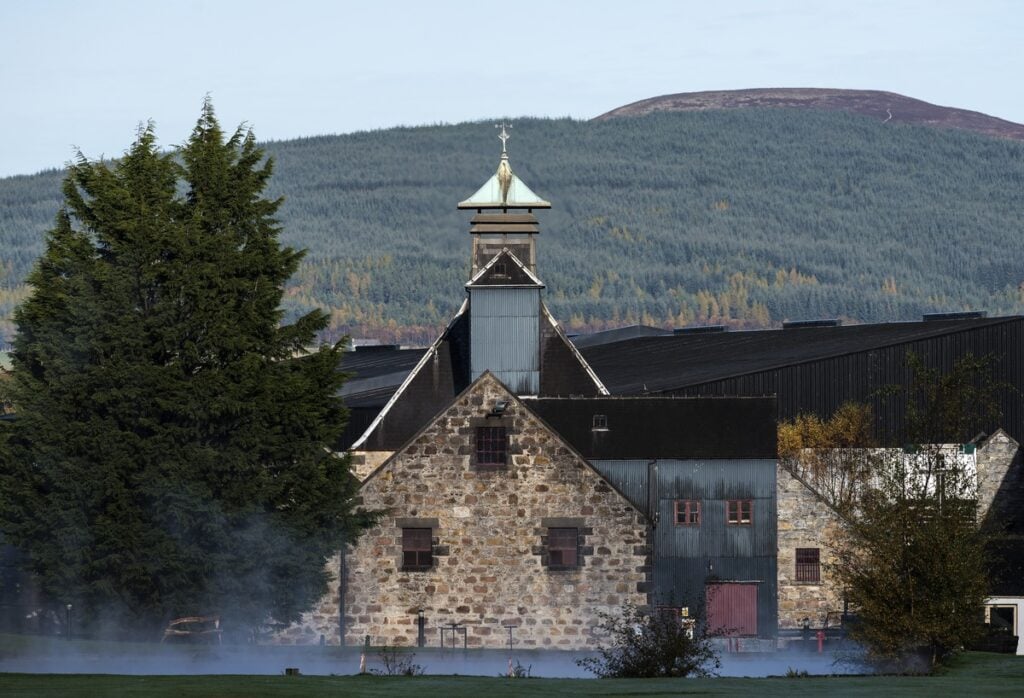
Welcome to Balvenie Distillery
Water, barley, and malt
Balvenie’s water source is the nearby Robbie Dhu Spring, which it shares with neighbour Glenfiddich. It’s a crystal-clear stream that runs through the valley, providing the distillery with high-quality water essential for mashing and cooling.
The distillery grows its barley for malting, with grain grown on the family farm distilled separately each year. Malting occurs on its famous floor maltings, one of only a handful left in Scotland. This produces 10-15% of The Balvenie’s requirements. After steeping the barley in spring water, the grain is spread across the traditional malting floor before being turned by hand by the dedicated malt men up to four times a day, seven times a week.
Once the malted barley is ready, it’s transferred to the kiln where it’s dried using anthracite and a carefully judged amount of peat. Each year, one week of production is dedicated to peat, with barley peated to 20-40 ppm.
Mashing and fermentation
The Balvenie is equipped with an 11.9-ton full lauter mash tun, a large vessel where the barley grist is mixed with hot water to extract fermentable sugars. These are fermented in nine wooden and five stainless steel washbacks with a fermentation time of 64-68 hours, with a combination of yeasts used. This produces a wash around 8% ABV.
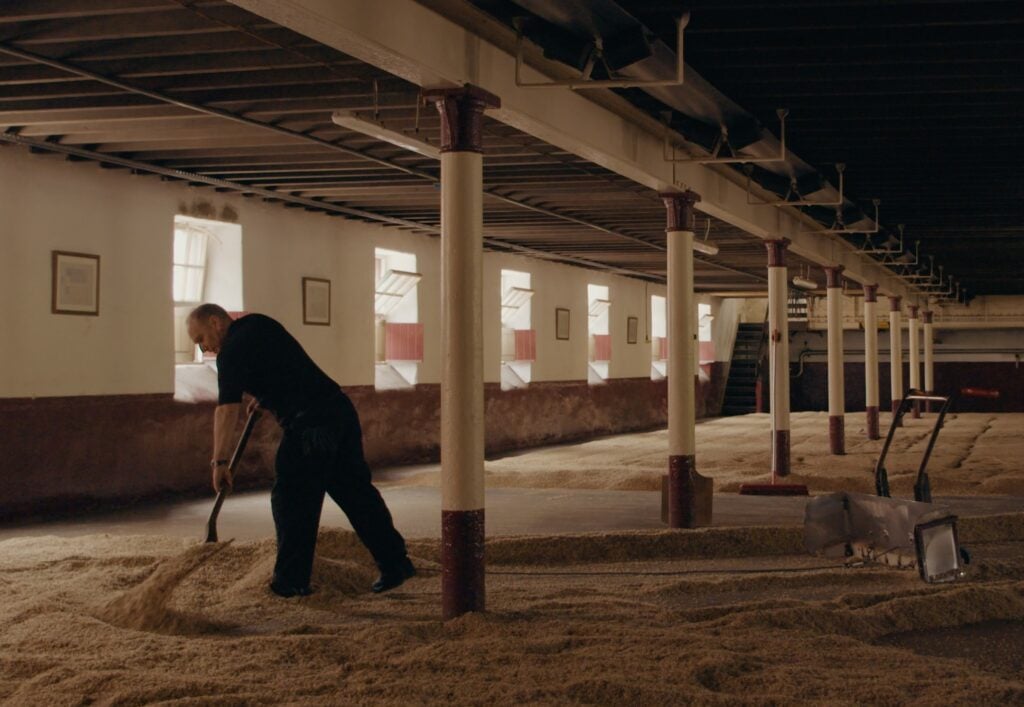
Traditional floor maltings at The Balvenie
Distillation
The wash is then distilled in Balvenie’s traditional copper pot stills. William Grant initially equipped the distillery with stills purchased from Lagavulin (£47) and the now-disappeared Glen Albyn (£93) distilleries to secure equipment with a track record of producing good whisky. Today, there are 11 stills at The Balvenie, each the spiritual descendant of the original. If the distillery wants to add a new still and condenser, it would need to splash out at least £250,000.
The Balvenie stills are large, high-necked, with a long head, twice as long as the Glenfiddich’s. They also have a distinctive “Balvenie Ball” in the neck, which looks almost like an Adam’s apple (which inspires the shape of its bottles). This is a deliberate design that increases copper contact with the expanded surface area and encourages reflux as the liquid condenses and falls back into the body of the still to be re-evaporated.
Some credit this cylinder with the honeyed characteristic of The Balvenie new make, which is also most definitely sweet and has a measured cereal note too. The Balvenie has its own dedicated team of coopersmiths who maintain its stills, rare these days. The name can be said for its on-site cooperage, stacked with an impressive team of 20. With that, we’ll move on to maturation.

Our mate Alwynne with the stills
Maturation
Most Balvenie whisky begins life in first-fill or refill bourbon American oak casks, but finishing is an art perfected here. Typically, that’s through sherry casks, but Stewart counted the Portwood finish as his favourite and our whisky under the spotlight today was aged in Caribbean rum casks.
The Balvenie boasts an array of traditional dunnage warehouses, buildings constructed from stone that provide an optimal maturation environment. The thick, insulated walls keep summers cool and winters warm (relatively for Scotland, at least) and create a steady ageing process that means the distillery can age whisky for a long time.
Warehouse No. 24 is the most famous onsite. It was once the malting floors and even incorporates stones from the original Balvenie Castle. The castle was said to have been built for a Lord’s mistress, and her ghost is rumoured to haunt The Balvenie…

Balvenie legends Dennis McBain, David Stewart, and Ian McDonald
The creator: a legend
The man who made Balvenie 14 Year Old Caribbean Cask is one of the most revered names in all of whisky: Dave C. Stewart MBE.
The master distiller emeritus is the kind who lets the whisky do the talking, quietly shaping the process while letting the spirit shine, not his ego. While others might shout about their genius, Stewart has always known that whisky’s true beauty lies in preserving the distillery’s character, not in glorifying the creator. And create he did.
He started in 1962 as a humble clerk, but tea duty and stock checks quickly evolved into an immersion in whisky-making, thanks to the esteemed Hamish Robertson. It wasn’t long before Stewart was crafting classics like Glenfiddich 8 Year Old and learning from some of the best in the business.
Fast-forward to 1974, and with Hamish moving on, Stewart found himself at the helm of Balvenie with no more than a “probationary” period to prove himself. Safe to say, he passed with flying colours. By the ’80s, when most distilleries were struggling, Stewart was crafting whisky that would change the game. The idea was “finishing” whisky in two casks, starting with a bourbon barrel and then transferring the liquid to a sherry barrel for a final period of maturation. The idea is a revelation. It became so successful, it practically defined a whole new approach to whisky-making.
In the ’90s, The Balvenie hit the big time, with DoubleWood first hitting the shelves in 1993, followed by Portwood. These are pioneers in the cask finishing movement. By the time we hit the Noughties, releases like the Madeira and Caribbean Cask had cemented the legend.
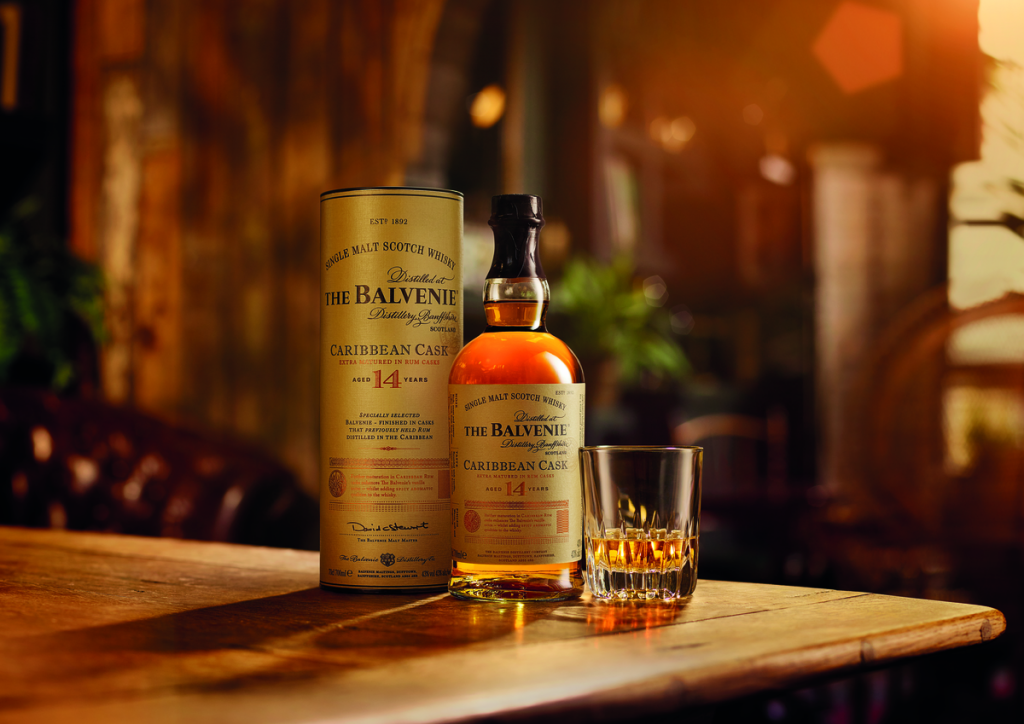
Our Classic whisky is Balvenie 14 Year Old Caribbean Cask
The story of Balvenie 14 Year Old Caribbean Cask
Balvenie 14 Year Old Caribbean Cask wasn’t actually the first rum-cask aged whisky The Balvenie released. That honour goes to the Golden Cask Rum Reserve, and good luck getting your hands on bottles of it now. Then came the Cuban cask edition. Unfortunately, nobody considered that a whisky called that couldn’t be sold in the brand’s largest market – The United States of America – because… you know… Cuba. With bottles ready for release, all distribution shifted to France, where you still might be able to find a bottle.
Finally, the Balvenie 14 Year Old Caribbean Cask was released in the early 2000s. Its success owes to a number of factories. Chief being that it’s very, very tasty. That is really the most important bit, after all. The sweet, honeyed, vanilla, and aromatic-spice-led nature of rum is a perfect match to the Balvenie’s signature house style. Sometimes you want to add contrasting elements with a finish, sometimes you want to double down. The Balvenie did the latter with aplomb.
It also solved a problem that rum casks tend to have: consistency. The rum cask market is vast but not as steady as bourbon or sherry. If you want a whisky to taste the same batch to batch, you need traceability, supply, and profile to be on the money for every cask you buy. Unless you’re creative and leverage a long-term friendship to go another route.
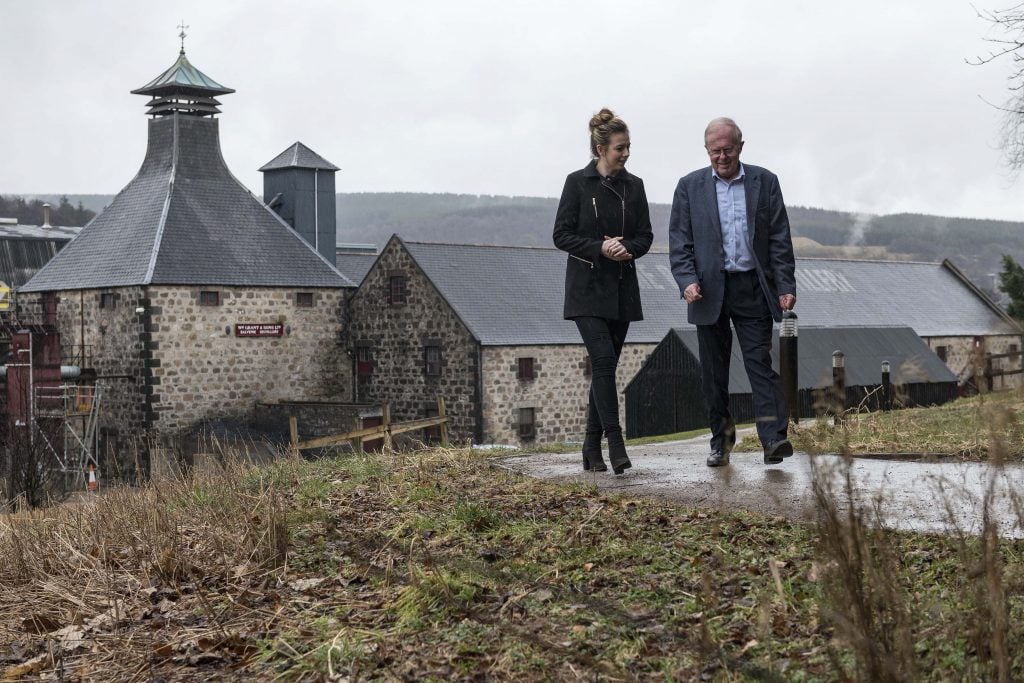
The Balvenie malt masters, past and present
Getting high on your own supply
A bromance between Stewart and John Barrett, owner and M.D of Bristol Classic Rum, was the key to Balvenie 14 Year Old Caribbean Cask. Barrett had the stock and expertise available to him to blend a bespoke rum (in The Netherlands*) for exclusive Balvenie use.
This allowed the Banffshire distillery to totally own the process. That means consistency not just in supply, but in maturation climate, as it all takes place in Scotland. The Balvenie seasons its own American oak casks for six months with this rum, and uses these casks to finish whisky that has spent at least 14 years in bourbon American oak casks. Glenfiddich uses the same process for its Reserva Rum Cask Finish.
What happens to all that Balvenie-influenced rum they take out of the cask to make room for whisky? Previously, it was sold back to rum producers, which means for a time there were stocks of it floating around. Sadly, the rum companies would never say where the spirit went, so we have no way of knowing if any remains, and this practice has also stopped. Now that rum is used in another William Grant & Sons product, Discarded Banana Peel Rum.
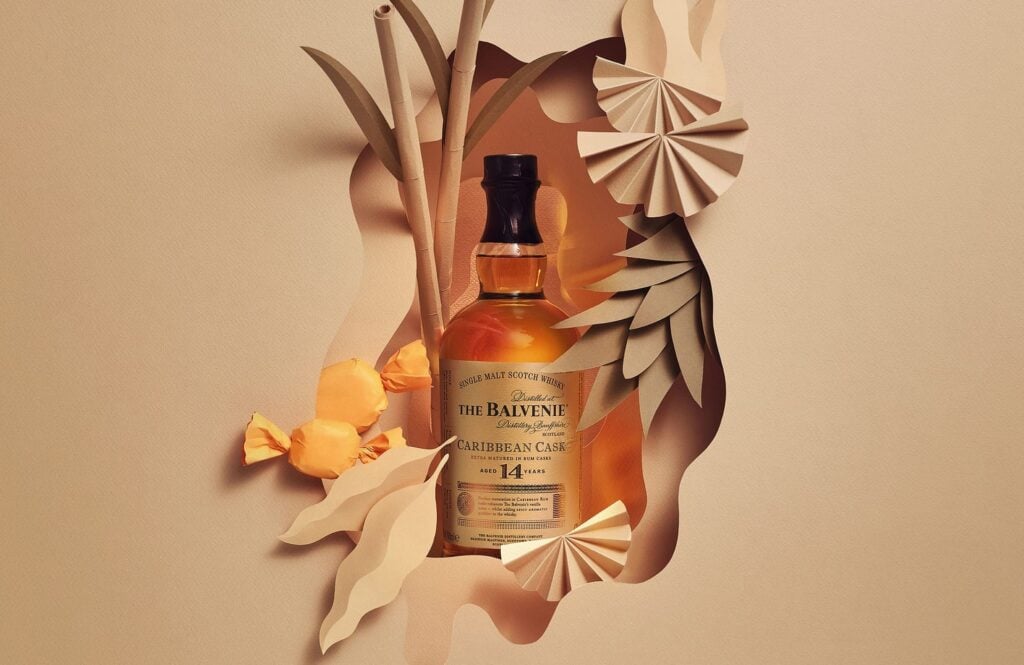
You can buy Balvenie 14 Year Old Caribbean Cask from Master of Malt
Balvenie 14 Year Old Caribbean Cask tasting note:
There you have it. The story of Balvenie 14 Year Old Caribbean Cask and the distillery behind it. The only thing left to do now is taste it.
Nose: The aroma is rich with notes of tropical fruits, namely passion fruit, and creamy toffee.
Palate: Sweet vanilla forms a creamy palate with notes of apples and mangoes with a hint of orange in the background.
Finish: The finish lingers with a vanilla-focused character.
You can buy Balvenie 14 Year Old Caribbean Cask from Master of Malt. Just click the link on the product’s name.
*Did you know Amsterdam is something of a rum capital? More on that in a future article.
